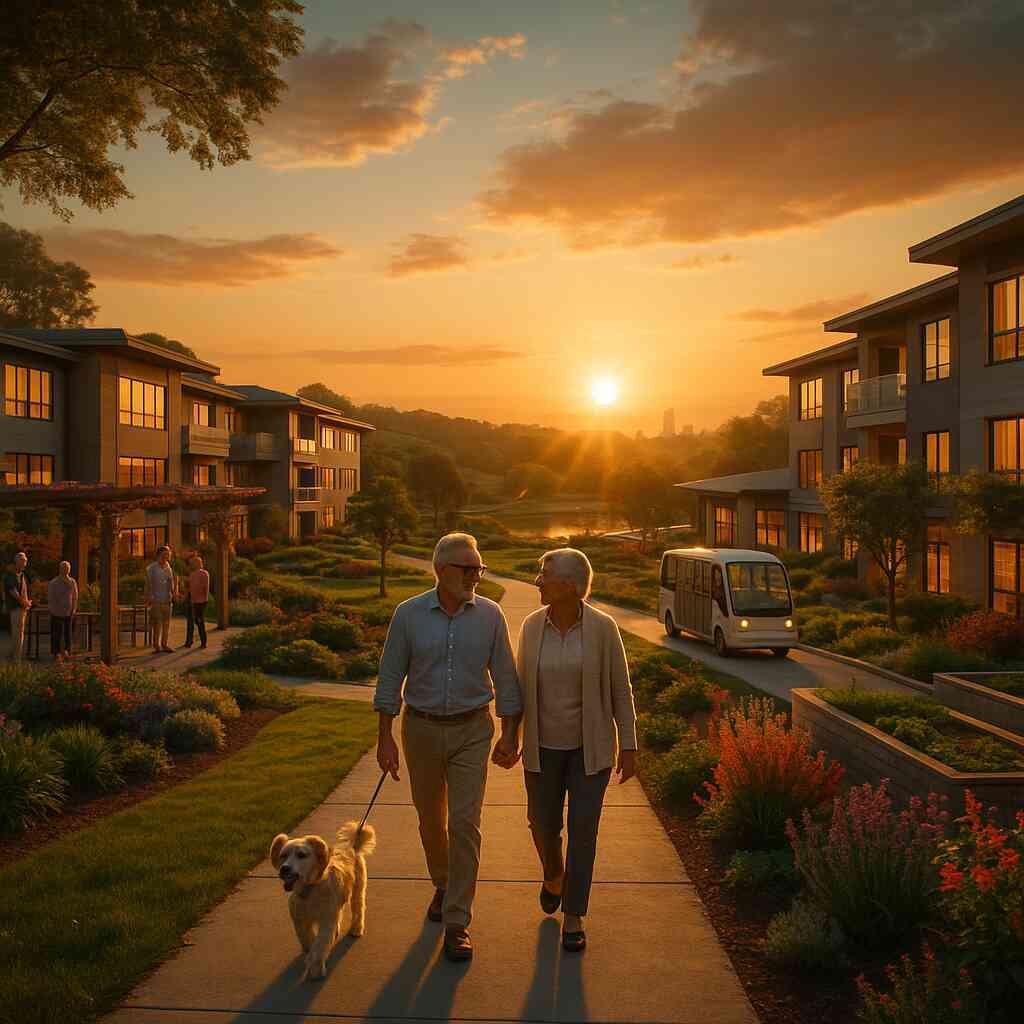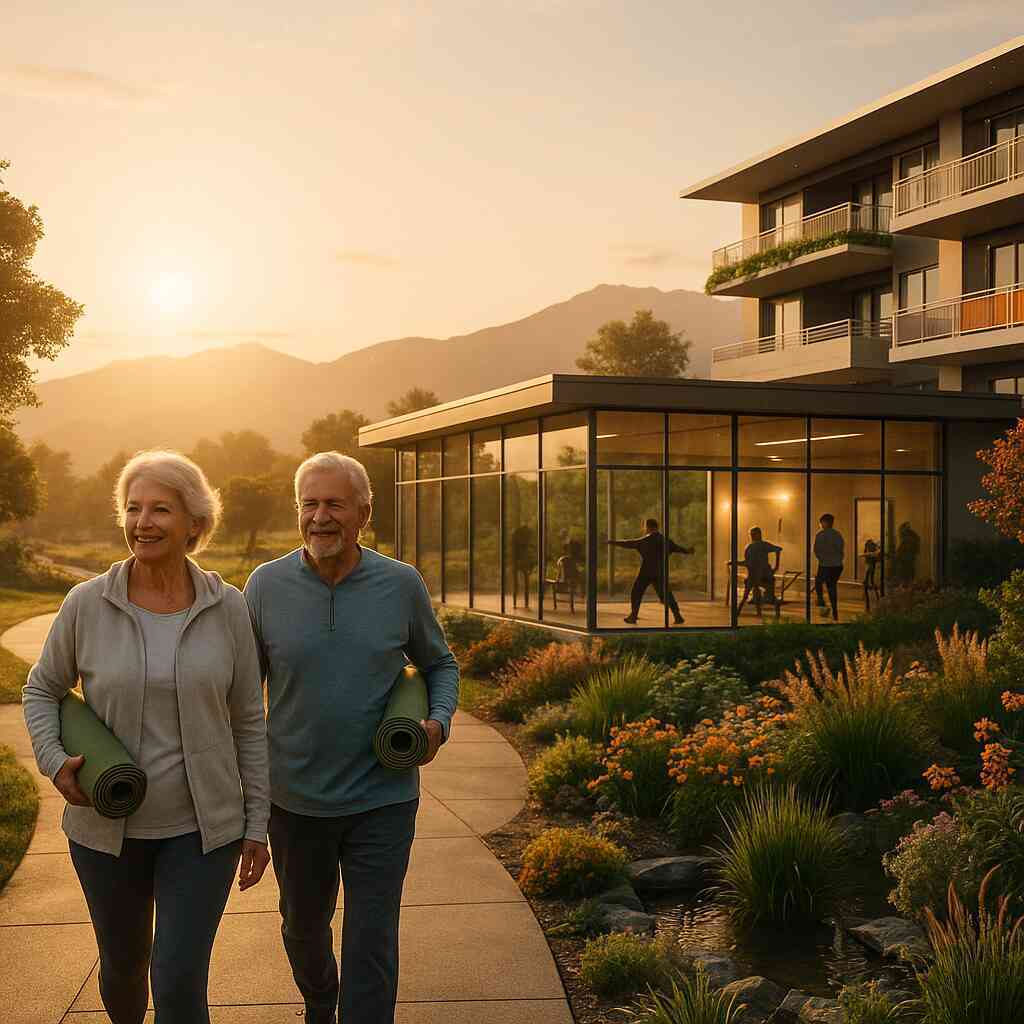
Exploring How Geographic Location Affects Senior Living
October 16, 2024
Discovering the Geographic Mosaic of Senior Living
Unveiling the Geographic Influence on Senior Lifestyle Choices
Geographic location profoundly influences the quality and character of senior living. Certain regions of the United States offer unique benefits tailored to senior residents, from climate to community services. For instance, warmer climates might alleviate arthritis symptoms and encourage outdoor activities, while areas known for their cultural vibrancy can provide seniors with rich social environments. Understanding the geographic influence on senior lifestyle choices helps families and individuals tailor their senior housing options, ensuring they align with personal health needs and lifestyle preferences. It’s crucial to consider how landscape and climate affect everyday life and well-being as seniors embark on this new chapter.
The geographic influence on the senior lifestyle is not just about physical comforts; it’s also about integrating into the local community, which can lead to enriched social connections. Regions like the Midwest, known for their neighborly vibe, often foster closer bonds in senior living communities. Conversely, coastal areas might provide serene, relaxing environments that are ideal for seniors seeking peace or those with hobbies linked to the sea. This variation underscores the importance of location when choosing a senior living facility, ensuring seniors find themselves in environments that mesh perfectly with their preferences and needs.
Geography also affects accessibility to healthcare, with some states offering a better nexus of hospitals and specialized senior care facilities. Healthcare accessibility is important as this can significantly impact seniors’ daily lives and overall health outlook. Geographic location can define how quickly seniors can receive medical attention during emergencies or routine check-ups, emphasizing the intertwined nature of geography and elder care. Thus, when considering geographic influence, families need to balance the aesthetic and environmental appeal of an area with practical healthcare considerations.
Mapping the Path to Optimal Senior Living Environments
Creating a pathway to optimal senior living involves a nuanced understanding of geographic features, climate preferences, and personal lifestyle needs. This journey often starts with assessing the climate suitability, as the weather plays a critical role in senior health and well-being. For example, regions with mild winters and ample sunshine can be ideal for seniors sensitive to colder temperatures. Climate effects on senior well-being are particularly relevant for those managing chronic conditions that can be exacerbated by extreme weather.
Mapping senior living environments requires an evaluation of local community services and amenities that cater to senior needs. Facilities with easy access to parks, libraries, and community centers can dramatically enhance seniors’ quality of life and promote an active lifestyle. Similarly, the proximity to family can be a deciding factor, making it essential to choose regions where family visits are feasible and frequent. Families mapping this path must stay informed about the regional availability of social and leisure activities, fostering a wholesome, fulfilling senior living experience.
Finally, understanding local laws and regulations regarding senior care is crucial to ensuring a safe and compliant senior lifestyle. Different states have varying standards and resources for senior care, which can affect everything from insurance coverage to the quality of available senior housing. By mapping these considerations, seniors and their families can make informed decisions that harmonize perfectly with personal and geographic desires for a content, safe living arrangement.
Anchoring Senior Living Decisions in Regional Landscapes
Regional landscapes play a pivotal role in anchoring senior living decisions, providing an essential backdrop against which daily life unfolds. Seniors who are nature enthusiasts might find solace near mountains or coastal landscapes that offer peace and daily enjoyment. What is the Definition of Independent Living? The landscape’s influence on the senior lifestyle transcends aesthetic pleasure, contributing significantly to mental and physical well-being.
Various regions offer distinct cultural and recreational opportunities that can enrich the senior living experience. Seniors who enjoy vibrant cultural activities might gravitate toward densely populated urban centers, which provide access to theaters, museums, and diverse dining options. Others may prefer quieter, rural settings where the community is tight-knit and open spaces promote relaxation and outdoor hobbies. Anchoring their living decision within such landscapes ensures seniors find joy in their surroundings every day.
Economic factors also play a part when anchoring in regional landscapes. The best states for senior citizens often provide a balance between cost of living and quality of care, making it essential to evaluate the economic sustainability of chosen locations. Regional disparities in cost can affect everything from housing affordability to access to premium services like health and wellness programs. By integrating these considerations, seniors can make sound decisions regarding living options that offer a fulfilling lifestyle balanced with economic prudence.
Navigating Climate Impacts on Senior Well-Being
The Role of Weather in Senior Health and Comfort
Weather plays a vital role in the health and comfort of seniors, making climate an essential factor in senior living decisions. Certain climates can exacerbate chronic conditions like arthritis and respiratory issues, impacting overall well-being. For instance, areas with high humidity may intensify arthritis pain, while dry regions might offer relief. Furthermore, weather influences daily activities, affecting seniors’ ability to engage in outdoor recreation or maintain an active lifestyle. Understanding these dynamics can aid in selecting senior living facilities that offer the most conducive environment for health, offering seniors the comfort they deserve in their golden years.
Adverse weather conditions, such as icy winters or extreme heat, can pose additional risks to seniors. Slippery sidewalks or intense heat waves can limit mobility, increasing reliance on in-home care services and supportive living facilities. It’s crucial to assess how these weather patterns influence day-to-day activities, ensuring seniors retain as much independence as possible. Consequently, families should prioritize geographic locations with climates that promote both physical activity and personal safety, striving for an optimal balance that enhances seniors’ quality of life.
Adapting Senior Care to Seasonal Changes
Seasonal changes demand adaptability in senior care, ensuring that seniors remain comfortable and healthy year-round. Senior living facilities often adjust their services based on seasonal requirements, offering heated environments during cold months or ensuring adequate cooling systems during hot summer days. These adaptations are crucial in maintaining consistent care quality, as sudden temperature changes can significantly impact seniors’ health, particularly for those with cardiovascular or respiratory conditions.
Aside from temperature controls, senior care facilities also need to adapt outdoor activities and wellness programs to seasonal variations. In colder months, indoor activities should be emphasized to keep seniors engaged and active without exposure to harsh weather. Conversely, warm weather months can focus on outdoor excursions and social events that allow seniors to enjoy the benefits of sunlight and fresh air, which are vital for mental and emotional well-being.
Accessibility factors in senior housing also encompass seasonal considerations, such as ensuring safe transportation during inclement weather. Facilities must provide reliable transport solutions, facilitating access to healthcare and essential appointments regardless of weather conditions. By integrating these adaptive strategies, senior living communities can offer a resilient framework that supports seniors through each seasonal transition, enhancing their overall living experience.
Climate Comfort Zones: Ideal States for Senior Residents
Identifying ideal states with favorable climate comfort zones is crucial for determining optimal senior living locations. Some states offer climates that naturally cater to the needs of seniors, providing mild temperatures and low humidity levels conducive to better health outcomes. Ultimate Guide to In-Depth Senior Living Choices For instance, senior living climate considerations are pivotal in states like Florida, where the gentle winters and abundant sunshine appeal to many retirees seeking comfortable and vibrant communities.
These climate comfort zones often correlate with regional senior living trends, where specific geographic areas attract retirees based on weather advantages. States with predominantly sunny days and minimal weather extremes tend to provide environments that reduce health risks, promoting not only physical well-being but also fostering a sense of rejuvenation and contentment. Identifying these regions can assist families and seniors in selecting senior living communities that best align with their climatic preferences, enhancing overall life satisfaction.
Economic evaluations, such as the cost of senior living near Alabama, should also be considered alongside climate factors. Balancing economic constraints with climate comfort ensures seniors reside in affordable regions without compromising on their health needs. Therefore, an integrative approach, considering both financial sustainability and climate comfort, can guide families toward the most fulfilling and sensible senior living arrangements.
Urban Versus Rural: A Tale of Two Senior Living Experiences
Contrasting Senior Lifestyles in Metropolitan vs. Countryside Settings
Metropolitan areas and countryside settings offer vastly different experiences for seniors, each presenting unique benefits and challenges. Urban environments provide easy access to essential services and amenities, fostering an active and engaging lifestyle for senior living community residents. In contrast, rural settings offer tranquility, allowing seniors to relish peaceful living far from the hustle and bustle. This urban vs rural senior lifestyle comparison is crucial when considering factors like personal preferences and health conditions. Seniors choosing between these environments must weigh the social advantages of city life against the serene, stress-free rural ambiance, making a choice that aligns with their desired lifestyle and care needs.
In metropolitan settings, seniors benefit from proximity to healthcare facilities, diverse grocery options, and public transportation networks, streamlining daily life and ensuring convenience. Conversely, rural living might require seniors to travel longer distances for services, potentially impacting those with limited mobility. Thus, seniors and their families should evaluate these lifestyle disparities meticulously, recognizing the role geographic location plays in fostering independence and well-being. Ultimately, it is about finding the right balance and ensuring seniors access a lifestyle that promotes their health and happiness.
The Influence of Urban Density on Senior Socialization
The dense population of urban areas hugely influences social connections, reflecting regional trends in senior care. Many seniors benefit from the high concentration of peers, enhancing opportunities for interaction and community engagement. Urban senior living facilities often arrange social events, educational programs, and cultural excursions, facilitating robust social networks essential for emotional health. By considering how to find senior living facilities, families can identify communities that thrive on socialization, fostering an environment where seniors continuously engage and connect.
Socialization opportunities in cities contribute significantly to improved quality of life for seniors. Cities offer cultural attractions such as museums, theaters, and community centers where seniors can indulge in artistic pursuits and maintain cognitive agility. The sense of community in urban environments prevents isolation, a prevalent issue among seniors, reducing depression risks and promoting overall happiness. Seniors residing in these vibrant settings can harness urban density’s socialization benefits, leading an active, fulfilling life marked by meaningful interactions and connectedness.
Rural Retreats: Benefits for Senior Independence and Serenity
Rural retreats offer seniors a unique lifestyle characterized by independence and peace, perfectly aligning with personal preferences for tranquility and self-sufficiency. The natural landscapes of rural areas foster a serene living environment conducive to mental and physical well-being. Guide to Senior Apartments in New Jersey Living in these settings allows seniors to engage with nature, which boosts their health and enhances life satisfaction. The natural environment and senior health connection underscores the importance of selecting a geographic location that complements a senior’s lifestyle and health priorities.
Moreover, rural living can empower seniors with a sense of control over their daily routines, fostering autonomy in an environment where life’s pace is gentler and neighborly connections are personal. However, choosing a rural retreat necessitates careful consideration of accessibility factors in senior housing, including transport solutions and medical service availability. Despite these challenges, rural settings offer undeniable benefits for seniors seeking independence and tranquility, making this option attractive for those prioritizing serenity and strong community bonds over urban conveniences.
Proximity and Accessibility: Key Factors in Senior Living
The Importance of Healthcare Accessibility for Seniors
Healthcare accessibility is a critical determinant in senior living, significantly impacting the quality of life in senior communities. Proximity to medical facilities ensures that seniors receive timely care, which is crucial for managing chronic conditions and emergencies. When looking for proximity to healthcare for seniors, families should prioritize locations where medical services, like hospitals and clinics, are nearby. This accessibility reduces stress for both seniors and their loved ones, guaranteeing peace of mind knowing that essential healthcare resources are readily available. Additionally, healthcare accessibility often correlates with varied options in senior living, meaning more personalized medical plans and specialized care suited to individual health requirements.
Furthermore, living in areas with robust healthcare infrastructure enhances seniors’ overall well-being. It fosters a preventive approach to health management, where regular check-ups and early intervention become routine, thereby minimizing serious health episodes. Encouraging family members to choose communities near quality healthcare resources aligns with best practices in senior care strategies. Overall, choosing a geographic location that supports comprehensive healthcare accessibility is pivotal for maintaining the health, safety, and comfort of seniors in their chosen communities.
Transportation Challenges and Solutions for Elderly Care
Transportation remains a critical aspect of senior living, influencing access to healthcare, social activities, and daily necessities. Addressing transportation access in senior living is essential to supporting independence and quality of life. Many seniors face challenges with mobility, requiring reliable transport solutions to navigate their communities effectively. Senior living facilities often offer shuttle services or partnerships with local transit systems to overcome these barriers, ensuring seamless connectivity within and beyond community boundaries.
Implementing innovative transportation solutions can significantly ease logistical constraints for seniors. Options such as ride-sharing programs tailored to seniors’ needs, volunteer driver pools, and subsidized transport services enhance mobility and independence. Facilities committed to these solutions prioritize residents’ freedom to participate in social and recreational activities without relying heavily on family or caregivers. By addressing and solving transportation challenges, senior living environments ensure that seniors remain active and engaged, promoting a well-rounded lifestyle in a supportive environment.
Moreover, senior care leaders continually explore cutting-edge solutions, such as autonomous vehicles and on-demand transport apps, to enhance accessibility. Such advancements underscore the importance of technology in overcoming transportation hurdles, marking a progressive step toward adaptive and inclusive senior living communities. An integrated transport strategy complements healthcare accessibility, collectively boosting the contentment and fulfillment of seniors within their living environments.
Prioritizing Local Amenities for Enhanced Senior Quality of Life
Local amenities play a vital role in shaping the senior living experience, directly affecting residents’ happiness and lifestyle satisfaction. The importance of local amenities for seniors cannot be overstated, as they encompass recreational, cultural, and essential services that cater to various lifestyle aspects. Access to amenities like parks, fitness centers, shopping areas, and dining options enriches daily life, offering convenience and opportunities for social interaction. When senior living communities integrate these attractions nearby, they create vibrant environments that encourage active, engaged living.
Families and seniors should evaluate the availability of local amenities when considering senior housing options. Communities boasting diverse amenities promote physical activity, mental stimulation, and social connections, which are crucial for maintaining a high quality of life. For instance, access to cultural events, hobby clubs, and learning opportunities contributes significantly to seniors’ cognitive wellness and emotional health. Selecting a residence in an area with rich amenity offerings ensures that seniors can pursue their interests and maintain an active, engaged lifestyle.
Ultimately, planning with local amenities in mind fosters a holistic approach to senior care, blending convenience with opportunities for enrichment and relaxation. Facilities well-versed in regional disparities strategically position themselves in thriving areas, addressing the need for balanced lifestyles. This foresight not only improves residents’ well-being but also reinforces the appeal of senior communities as dynamic spaces for aging, promising long-term satisfaction and contentment.
Cultural and Economic Variations in Senior Living
Cultural Nuances and Senior Community Integration
Cultural nuances significantly shape the integration of seniors into their communities, highlighting the cultural impacts on senior communities. These impacts determine how well seniors connect with their surroundings and peers, affecting their emotional and social well-being. Communities that embrace cultural diversity offer tailored experiences that resonate with individual backgrounds and traditions. Moreover, recognizing cultural variances allows senior living facilities to offer programs and services that reflect diverse histories, cuisines, and artistic preferences, thus enriching the living experience for residents.
Social gatherings, language-focused clubs, and culturally themed events can significantly enhance the quality of life for seniors, ensuring they feel understood and welcomed. This culturally sensitive approach not only fosters belonging but also combats isolation, a common challenge in senior communities. By integrating cultural appreciation into daily routines, senior living environments cultivate vibrant, inclusive atmospheres that support emotional health. The focus on culture ensures a comprehensive strategy for involving seniors, reinforcing the importance of cultural nuance in shaping community dynamics and boosting satisfaction.
The Economic Spectrum of Senior Housing Options
The economic landscape of senior living is as varied as the communities themselves, encompassing everything from budget-friendly options to luxurious residences. Senior housing options span independent living communities, assisted living facilities, and full-service nursing homes. This spectrum caters to different financial capabilities and care requirements. Understanding the factors influencing cost, such as location, services provided, and amenities, is crucial for making informed decisions.
Many families explore finding assisted vs independent living options based on financial considerations and care needs. Assisted living facilities typically offer more services, which can result in higher costs compared to independent living residences designed for seniors who require minimal assistance. Exploring an economic spectrum ensures seniors find housing options that harmonize with their financial situations and care preferences, leading to sustainable living arrangements.
Besides costs, economic evaluations must consider the broader financial implications, such as insurance coverage and state regulations affecting senior care prices. By navigating this spectrum thoughtfully, seniors and their families can secure housing solutions that promise stability, comfort, and comprehensive care tailored to individual needs without financial strain.
Regional Disparities in Senior Living Costs and Services
Regional disparities in senior living costs and services reveal stark contrasts in affordability and care quality across the United States. Various regions present diverse cost structures for senior living, shaped by local economic conditions, demand, and regulatory environments. For instance, areas known for a high density of senior citizens often offer a broader range of services but at a higher price point, influenced by regional factors like labor costs and real estate values.
Understanding regional disparities in senior care equips families with crucial insights for making informed decisions about senior housing. Regions with fewer senior living facilities might have lower costs but limited service availability, impacting care quality. Conversely, areas with ample facilities may provide excellent services but with a steep price tag. Balancing these disparities involves evaluating both economic and care quality metrics.
Geographic disparities necessitate careful research into local markets to identify states or areas that offer the best combination of affordability and superior care. By strategically leveraging this knowledge, families can maximize seniors’ well-being while managing expenses effectively. Ensuring that seniors receive quality care without being financially overwhelmed involves understanding regional trends, making it a vital component of successful senior living planning.
Concluding Reflections on Geographic Choices in Senior Living

Synthesizing Geographic Factors in Senior Living Decisions
Geographic factors play a critical role when choosing the most suitable senior living environment. Seniors and their families must consider the interplay between climate, healthcare accessibility, and local amenities when deciding on a residence. Recognizing these elements influences the quality of life and aligns with personal health and lifestyle preferences. Urgent access to healthcare facilities, for instance, is vital for managing chronic conditions, which adds another layer to geographic decisions. As such, a holistic approach ensures that seniors reside in areas that harmonize with practical needs and personal enjoyment, ensuring a seamless transition into senior living communities.
Another geographic consideration is the cost of senior living near Georgia, highlighting how location affects affordability and available services. The economic aspect of geographic variation underscores the importance of strategic choices when planning for senior living. Combining cost-effectiveness with healthcare accessibility and enriching local amenities enables seniors to live comfortably while benefiting from comprehensive care and engagement. Ultimately, synthesizing these geographic elements leads to well-informed decisions tailored to diverse senior living needs.
Forecasting Regional Senior Living Trends
The evolving landscape of senior living is shaped by shifting regional trends that highlight new priorities and preferences in elder care. Regions across the United States demonstrate varying trends based on demographic changes, healthcare advancements, and economic fluctuations. What is the Future of Senior Living in 2024? Awareness of these regional trends in senior care allows families to anticipate and prepare for future shifts that may impact senior living choices.
Factors such as climate change, advancements in medical technology, and changes in retirement and healthcare policies will continue to influence regional senior living dynamics. These trends can affect the availability of services and the design of new communities, creating opportunities for innovative living solutions. Monitoring these trends offers foresight into future developments and encourages the adoption of adaptable and forward-thinking strategies.
By staying informed about regional variations, senior living facilities, and families can proactively adapt to emerging needs, ensuring that seniors consistently receive high-quality care. This forward-thinking approach not only secures a stable environment for seniors but also facilitates the ongoing evolution of senior living standards that align with changing times.
Empowering Seniors with Geographic Insight
Empowering seniors with geographic insight involves equipping them with the knowledge to make informed decisions regarding their living environments. Understanding the impact of location on quality of life and care accessibility helps seniors actively participate in their housing choices, fostering independence and self-assurance. Geographic insight encompasses climate comfort, healthcare proximity, and the comparison of urban vs. rural senior lifestyles, ensuring seniors find communities compatible with their lifestyles.
Accessible information and professional guidance from platforms like Senior Living Facilities play pivotal roles in this empowerment journey. These resources streamline the process of evaluating and selecting senior living options tailored to geographic preferences and individual needs. The emphasis on personalized guidance supports seniors and their families in navigating the complexities of senior living decisions with confidence.
Ultimately, empowering seniors with geographic insights transforms the selection process into a collaborative and gratifying experience. It reinforces the narrative that senior living choices are not just about settling for comfort but about optimizing life satisfaction through well-considered geographic elements, ensuring that seniors thrive in their chosen communities with dignity and autonomy.
Frequently Asked Questions
Question: How does geographic location impact the quality of life for seniors in senior living communities?
Answer: Geographic location plays a significant role in shaping the quality of life for seniors in senior living communities. The Future of Senior Living in 2024 Various factors such as climate, proximity to healthcare services, and access to local amenities can greatly influence seniors’ daily experiences and overall well-being. For instance, warmer climates are beneficial for seniors with conditions like arthritis, while regions with abundant healthcare facilities ensure quick access to medical services. Furthermore, areas rich in local amenities offer numerous social and recreational activities that contribute to a fulfilling lifestyle. By choosing the right geographic location with the help of Senior Living Facilities, seniors can enjoy a comfortable and enriched living experience.
Question: What are the benefits of considering climate effects on senior well-being when selecting a senior living facility?
Answer: Considering climate effects is crucial when selecting a senior living facility because weather conditions can significantly impact senior well-being. Ideal climates with mild temperatures and low humidity can alleviate symptoms of certain medical conditions and promote outdoor activities. For example, seniors experiencing respiratory or joint issues may benefit from regions with drier climates. Understanding these impacts helps families and seniors choose living environments that cater to their health needs while promoting an active lifestyle. Comparing Assisted Living, nursing homes and Senior Living Facilities offers insights into various climate zones, helping you match your preferences with the optimal locations available across the United States.
Question: How can Senior Living Facilities assist in exploring the best states for senior citizens highlighted in the blog title ‘Exploring How Geographic Location Affects Senior Living’?
Answer: Senior Living Facilities is dedicated to helping seniors and their families navigate the complex landscape of senior living options across different states. By leveraging our extensive database, we assist you in evaluating factors such as cost of living, climate conditions, and accessibility to healthcare, ensuring your choice aligns with the insights presented in the blog title ‘Exploring How Geographic Location Affects Senior Living.’ How to Compare In-Home Care and Senior Facilities Near You? Our platform not only offers a comparison of different states but also connects you with communities that meet your specific needs, making it easier to identify the best states for senior citizens that offer a balance of care quality and lifestyle benefits.
Question: What role do local amenities play in enhancing the senior living experience, and how can they be evaluated through Senior Living Facilities?
Answer: Local amenities significantly enhance the senior living experience by providing opportunities for social engagement, physical activity, and cultural enrichment. Access to parks, fitness centers, shopping areas, and cultural events ensures a vibrant lifestyle that promotes health and happiness. Why Choose Senior Living in California for 2024? Senior Living Facilities helps families and seniors evaluate the availability of these amenities by providing detailed information on senior living communities throughout the country. By understanding the importance of local amenities, Senior Living Facilities guides you in choosing communities that cater to specific interests and needs, thereby enriching the overall quality of life for seniors.
Question: How can geographic mobility in senior living influence the choice between urban vs rural senior living environments?
Answer: Geographic mobility in senior living is a crucial factor to consider when choosing between urban and rural environments. Urban senior living environments provide easy access to healthcare facilities, diverse amenities, and robust social networks, which are essential for maintaining an active and social lifestyle. Conversely, rural settings offer tranquility and a slower pace of life, suited for seniors seeking independence and serenity. Ultimate Guide: Aging in Place vs Senior Communities What Does Aging in Place Mean for Seniors in 2024? Senior Living Facilities assist in evaluating these contrasting environments, highlighting how geographic mobility influences daily living experiences. By understanding these dynamics, seniors and their families can make informed decisions that align with personal preferences and lifestyle goals, ensuring a comfortable transition into the chosen senior living community.



